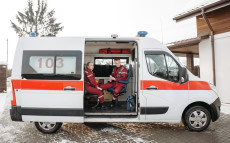- pathfindersAI
- Job Profile
Emergency Medical Technicians
Summary
Emergency Medical Technicians: A Vital Role in Healthcare
What They Do
Emergency Medical Technicians (EMTs) are indispensable first responders in emergency medical situations. They provide critical, front-line care for individuals suffering from sudden illnesses or injuries. EMTs often serve as the initial point of contact in emergency scenarios, such as car accidents, heart attacks, and natural disasters. They offer immediate, life-saving interventions and ensure that patients are stabilized before they are transported to healthcare facilities for further treatment. EMTs operate in high-stress environments, requiring them to make swift, informed decisions that can mean the difference between life and death.
Job Responsibilities
The responsibilities of an EMT are diverse and multifaceted. EMTs assess a patient's condition, manage respiratory, cardiac, and trauma emergencies, and provide pre-hospital care. Their duties include administering CPR, wound care, and oxygen to patients in need. Additionally, EMTs must be skilled in operating complex medical equipment such as defibrillators and ventilators. They also play a crucial role in ensuring safe transportation, often driving ambulances and coordinating with other emergency responders. Completing detailed patient care reports and maintaining accurate medical records are essential administrative tasks that support the continuity of care.
Essential Skills
To excel in this profession, EMTs must possess a unique blend of technical and interpersonal skills. Medical knowledge is paramount, including proficiency in basic life support techniques and familiarity with emergency care protocols. Critical thinking and problem-solving abilities enable EMTs to assess situations accurately and act decisively. Physical stamina is necessary, as the job can be physically demanding, often requiring long hours and strenuous activities. Moreover, strong communication skills are vital for interacting effectively with patients, their families, and other healthcare professionals. Emotional resilience and the ability to remain composed under pressure are also crucial, given the potentially distressing nature of the work.
Educational Pathways
Becoming an EMT requires specific educational and certification pathways. Prospective EMTs must complete a state-approved training program, which typically lasts from 150 to 200 hours and includes both classroom instruction and hands-on experience. These programs cover essential medical knowledge, practical skills, and emergency response strategies. Following training, candidates must pass a national or state certification exam. In many regions, additional certifications such as Advanced Cardiac Life Support (ACLS) and Pediatric Advanced Life Support (PALS) are recommended or required. Some EMTs choose to further their education by pursuing paramedic training or enrolling in degree programs related to emergency medical services, which can enhance career opportunities and earning potential.
Career Prospects
The career prospects for EMTs are promising, with the Bureau of Labor Statistics projecting a steady growth rate in the coming years. The demand for emergency medical services is anticipated to rise due to an aging population and an increase in chronic health issues. EMTs can work in various settings, including ambulance services, fire departments, hospitals, and private healthcare facilities. With experience and additional training, EMTs can advance to higher roles such as paramedics, emergency management directors, or medical instructors. The profession also offers a strong foundation for those interested in pursuing further medical or healthcare careers.
Conclusion
In conclusion, Emergency Medical Technicians play a critical role in the healthcare continuum. Their ability to provide immediate care during emergencies is vital to saving lives and improving patient outcomes. The job demands a robust set of skills, comprehensive training, and a dedication to serving others in high-pressure environments. As the need for emergency medical services continues to grow, becoming an EMT represents a fulfilling and impactful career choice, offering opportunities for advancement and lifelong learning. EMTs exemplify the spirit of service and commitment at the heart of the healthcare field, proving to be true guardians of public health and safety.
Video
Compensation
| State | Median Salary | Median Hourly | Positions |
|---|---|---|---|
| AL | 34,550 | 16.61 | 2,660 |
| AK | 51,850 | 24.93 | 390 |
| AZ | 34,260 | 16.47 | 3,000 |
| AR | 33,890 | 16.29 | 1,100 |
| CA | 45,110 | 21.69 | 18,800 |
| CO | 41,700 | 20.05 | 3,500 |
| CT | 46,770 | 22.49 | 2,530 |
| DE | 41,600 | 20.00 | 910 |
| DC | 47,440 | 22.81 | 320 |
| FL | 37,120 | 17.85 | 5,960 |
| GA | 37,270 | 17.92 | 5,250 |
| HI | 59,300 | 28.51 | 560 |
| ID | 35,460 | 17.05 | 730 |
| IL | 39,260 | 18.87 | 7,610 |
| IN | 37,680 | 18.11 | 3,630 |
| IA | 37,620 | 18.09 | 1,290 |
| KS | 30,890 | 14.85 | 1,850 |
| KY | 35,670 | 17.15 | 2,750 |
| LA | 34,100 | 16.39 | 1,970 |
| ME | 40,420 | 19.43 | 1,100 |
| MD | 46,320 | 22.27 | 2,530 |
| MA | 45,920 | 22.08 | 4,360 |
| MI | 36,070 | 17.34 | 4,480 |
| MN | 45,750 | 21.99 | 3,020 |
| MS | 30,560 | 14.69 | 1,230 |
| MO | 35,680 | 17.15 | 3,670 |
| MT | 35,220 | 16.93 | 810 |
| NE | 37,370 | 17.97 | 390 |
| NV | 37,730 | 18.14 | 1,170 |
| NH | 40,750 | 19.59 | 1,010 |
| NJ | 46,380 | 22.30 | 5,790 |
| NM | 37,280 | 17.93 | 1,270 |
| NY | 44,430 | 21.36 | 11,330 |
| NC | 38,710 | 18.61 | 7,000 |
| ND | 38,110 | 18.32 | 810 |
| OH | 38,290 | 18.41 | 4,570 |
| OK | 31,190 | 15.00 | 1,980 |
| OR | 46,340 | 22.28 | 1,540 |
| PA | 36,870 | 17.72 | 8,000 |
| RI | 44,670 | 21.48 | 430 |
| SC | 37,430 | 17.99 | 4,350 |
| SD | 37,990 | 18.26 | 800 |
| TN | 36,960 | 17.77 | 3,540 |
| TX | 35,850 | 17.24 | 12,380 |
| UT | 37,250 | 17.91 | 1,610 |
| VT | 36,880 | 17.73 | 750 |
| VA | 38,730 | 18.62 | 3,720 |
| WA | 41,770 | 20.08 | 2,580 |
| WV | 30,760 | 14.79 | 1,470 |
| WI | 40,590 | 19.51 | 4,100 |
| WY | 36,000 | 17.31 | 440 |
Similar Occupations
In this area you will find other occupations that are close to the one you were viewing in tasks, knowledge and work environment. If the primary job profile you are viewing isn't quite to your liking, take a look around and see what else is available.
Basic and Premium Accounts have more alternative occupations available than the Free account.

Acute Care Nurses - 29-1141.01
Acute Care Nurses provide immediate and intensive care to patients with severe, life-threatening conditions, often working in environments such as emergency rooms, intensive care units, and surgical wards. They monitor vital signs, administer medications, and collaborate with multidisciplinary teams to ensure rapid and effective treatment.
-
$86,070/yr
Median Pay -
3,175,390
Number of Jobs

Ambulance Drivers and Attendants, Except Emergency Medical Technicians - 53-3011.00
Ambulance Drivers and Attendants, Except Emergency Medical Technicians, primarily transport patients to and from healthcare facilities in a non-emergency capacity, ensuring safe and timely arrival. They also assist with patient handling and may provide basic care and comfort during transport.
-
$32,580/yr
Median Pay -
11,520
Number of Jobs